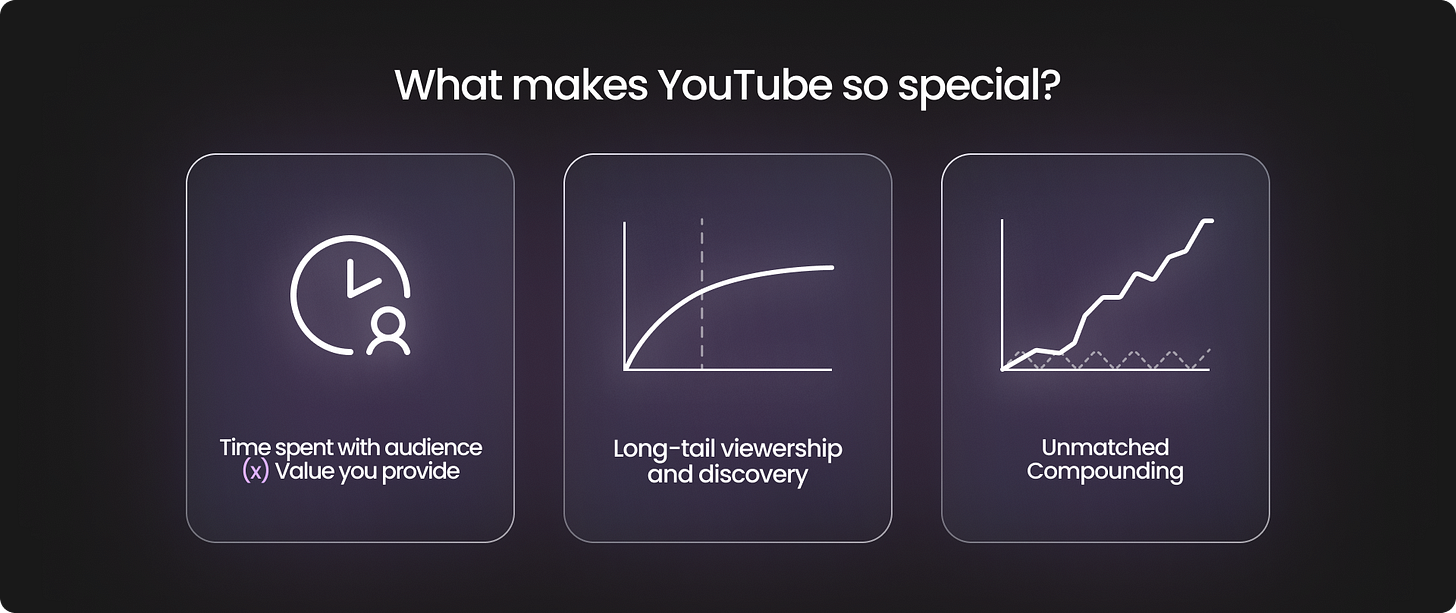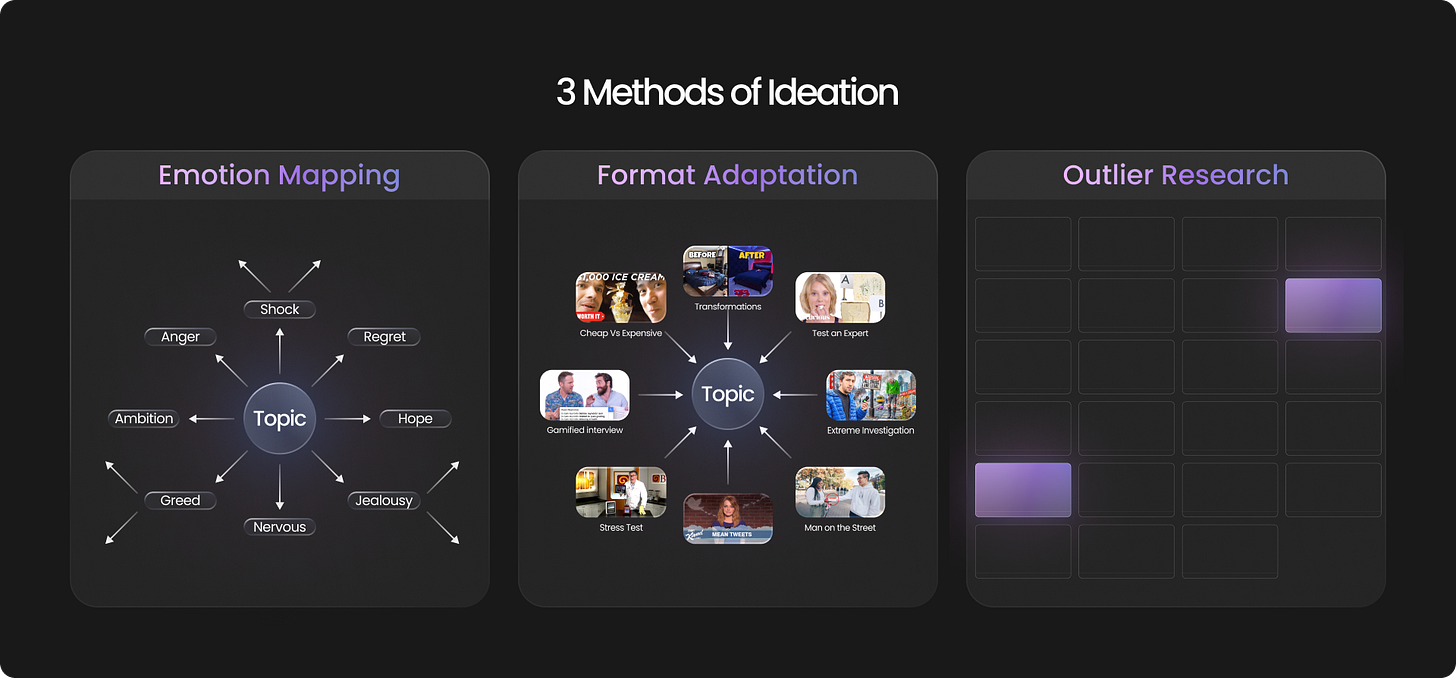How to grow a brand YouTube channel
The resources it takes to start an account, mistakes most brands make, content ideation tips, and more.
Today’s newsletter is sponsored by Snowball, the YouTube agency helping brands build world-class content that drives business.
The word on every social director’s lips right now? YouTube. In my 12 years working in social media, I have never heard so many brands wonder if they should finally join YouTube. The platform has the largest share of time spent on social media (by a long shot) yet it has historically been overlooked by social teams. I’m guilty of it too. I always assumed it was too expensive or too hard to crack. Today is my attempt to fix that thinking.
In this newsletter I am interviewing Ryan Hashemi. He has spent the last 15 years building content empires that have shaped YouTube. Funny enough, it was his background in Wall Street that led him to content. He’d make recommendations for where money should be invested, based on which companies he felt had a real lasting competitive advantage. It became painfully clear to him that a strong brand is one of the biggest advantages a company can have. While he was building the creative business at Jubilee (14M subscribers), major brands reached out for help with their own YouTube strategy. He saw an opportunity: Help brands understand the most powerful and most watched platform. That’s how his agency Snowball was born.
If your brand has been curious about what a YouTube strategy could look like, this newsletter is for you. We talk about the resources it takes to start a channel (with real numbers and estimates), the biggest mistakes he sees brands make (like “a packaging-last creative process”), accounts you should follow for inspiration, and lots more.
Rachel Karten: I want to start with a quick elevator pitch. What would you tell the CMO of a brand to convince them to invest in YouTube?
Ryan Hashemi: For over a decade, I’ve created content for social, SEO, and everything in between. YouTube is the only platform that has consistently gotten stronger and more reliable—and it just keeps breaking records. Video is king and YouTube is its kingdom.
Just a few things that put YouTube in a league of its own:
Average watch time per video is minutes (vs. seconds elsewhere)
YouTube has the greatest % of consumption across all devices, including TV according to Nielsen
YouTube is the second largest search engine in the world
90% of households with $100k+ income use YouTube monthly, according to Pew Research Center
The platform has deep analytics to drive success
It pains me to see amazing brands sit on the sidelines just because they don’t understand it.
RK: I think there's a notion that putting together a long-form YouTube strategy takes a lot of resources. What kind of investment does a brand need to make if they want to prioritize YouTube?
RH: Let’s talk numbers.
For long-form, a basic starting setup:
1 strong video producer (~$9K-$10K/month)
1 strong editor (~$8K-$9K/month)
A few thousand per month in production costs
That can get you one quality 10-15 min video every two or three weeks—enough to scale a channel with the right strategy. On top of our strategy and leadership, most clients budget around $400K/year for the creative team and production. We do have one client moving the needle with just one in-house producer and very little expenses.
For short-form, start with:
1 talented creator (~$10K/month)
Part-time editing and production support ($2K-3K/month)
That’s enough for 20-30 short-form pieces a month. Some brands double down with 2-3 creators to scale variety and volume.
Here’s what gets me.
Brands spend millions just to make an ad-spot that they think is good—then millions more to force it in front of people who’d rather not see it. Not with YouTube. Organic content compounds, builds a flywheel, and earns engaged attention for free. Even better—your top-performing organic content often becomes your best-performing and most-efficient paid asset.
RK: We hear a lot about media companies with successful YouTube strategies, but less about brands. Can you talk me through how a brand that sells a product can find success on the platform?
RH: This is my video conversion framework:
Make great content where your product or mission makes the content better. No, not a tacked-on promotion or placement—but where the product is organically part of the story. When done right, I’ve seen conversion lift by 500%–1,000% over typical in-video promotions.
One of my favorite but extreme examples of this is the old-school YouTube show, Will It Blend?
Blendtec was a commercial blender company with little consumer presence. They made a viral series blending wild objects (iPads, diamonds, etc.). Viewers were entertained and blown away by the product’s power. Over the next few years, sales jumped 700%—without a single hard sell.
RK: What's the biggest mistake you see brands make when they start posting on YouTube?
RH:
No real strategy or a strategy not based on anything real, leading to weak ideas. Most brands jump in without understanding what can work in their domain—or what their target audience actually watches. We spend 100+ hours upfront researching and ideating 100+ concepts, complete with titles and thumbnails—to maximize confidence. You don’t wing this.
Packaging-last creative process. Most teams first make a video that they think is going to be great, then scramble to find a title and thumbnail. That’s completely backwards. If you don’t have a must-click title and thumbnail before you shoot, don’t make that video. 40% of your effort should just be focused on this one-step, up-front.
Half-hearted “test” approach. I often hear that folks want to lightly “test” YouTube and see if there is anything worth investing more in after a few months. YouTube isn’t something you dip a toe into. It rewards consistency and compounds significantly over time. Plus, audiences can spot a lazy effort instantly. If you’re going to do it, do it right.
RK: I want to get into content strategy for YouTube. Can you give me a peek into your brainstorming process? Any frameworks you like to use?
RH: Here are my three methods of ideation:
Emotion Mapping: Start with the topic you are looking to make a video about and create branches out of that that tie to strong human emotions associated with that topic. Continue pulling on those emotions and focus the brainstorming around developing video concepts that most effectively elicit that strong human emotion. Viewer decision making is based on emotion. This is much more of a blue-sky, throw-ideas-on-a-whiteboard ideation.
Format Adaption: This is of the mindset that there is no such thing as a purely original idea. All ideas are just built on top of existing ideas. I have a running document of all the interesting formats and shows that exist across many different genres and I categorize them. Then I ask myself, is there anything about this proven format that can be leveraged to create something for our needs? The result is often confidence inspiring content (because it’s proven to work elsewhere) that still feels original and fresh.
Outliers: This is what most junior strategists do because it’s easiest. You use tools like 1of10 or ViewStats and look for successful videos across YouTube, specifically where the channel the video was uploaded on is a small channel. You’re looking for videos that CLEARLY won because the concept is strong. So a channel whose average videos are getting a couple thousand of views, but then has one video with hundreds of thousands of views. THAT is a video you can potentially replicate for your own niche.
RK: How does your agency Snowball work? How do you build a process to yield the greatest odds of success on YouTube for a brand?
RH: After our leadership, brands are left with the rare ability to create content their target audience will actually want to watch.
It’s all possible because of our team.
Deep Audience Research: We study hundreds of hours of content your target audience consumes to understand how they think and why they choose what they watch.
The Ideation Machine: We generate 100+ concepts—from proven formats, fresh angles, and unconventional ideas. We argue, rank, and refine to surface only the highest potential ideas.
Access to Great Talent: We hire creative talent that brands couldn’t access on their own. The best storytellers want to work with Snowball because they know they’ll grow working with us. We spend countless hours finding and vetting talent we’re confident will succeed.
Must-Watch Packaging: If no one clicks, the content doesn’t matter. We partner with the best thumbnail designers in the world—people behind almost a trillion views. We craft 20-30 title options and rigorously split-test until we find brand-aligned packaging that actually gets the click.
Building Your Internal Team: We lead and train production teams—producers, editors, and creatives—to operate at Snowball’s level. Our playbooks, frameworks, and standards become yours. You walk away with internal talent fully equipped to carry the content for years to come.
This process is complex and time-intensive for us—but takes almost no time from our partners. And it’s the best path to success.
RK: What metrics do you think are most important to track for a brand working on a YouTube strategy?
RH: The two metrics I obsess over: Click-Through Rate (CTR %) and Average View Duration (AVD). Together, they drive about 80% of a video’s success.
CTR shows how compelling your title and thumbnail are—how many people chose to click. AVD shows how long the video held their attention once they did. For Shorts, this is measured by "Stayed to Watch %".
There’s no magic to the algorithm—it’s just a proxy for how interesting real people found your video.
I also like to look at subscribers-per-thousand-views, engagement rates, and returning viewership.
RK: Are there any brands you think are doing a great job on YouTube? I'm sure people reading this would love some accounts to explore.
RH: The reason why Snowball is growing fast is because brands are now starting to really pay attention to YouTube. A handful that I think have a great start: TaylorMade Golf, Genius, Nothing, Ahrefs, GoPro, Y Combinator, Brevitē, Huckberry, Red Bull, SERHANT., LEGO, and Nectar.
RK: I've worked in this industry for 12 years. I have never heard so many social media managers mention that they are exploring a YouTube strategy. Why do you think this moment in time is leading marketers to more seriously consider the platform?
RH: Same. Paid ads are more expensive, less effective, and not as defensible. SEO is declining as a reliable source of traffic. The future of some other social platforms seems uncertain.
YouTube? It only consistently gets stronger…as it has for the past 15 years.
YouTube watch time is at record highs. It’s now #1 on TV screens and for podcasts. YouTube Shorts is booming. And the creator-economy brands making the biggest impact on their industries—IPSY, Feastables, Prime, Joyride, Ryan’s World—were born on YouTube. It’s always YouTube.
YouTube-first is also an efficient content engine. One great video can fuel your Shorts, Reels, TikTok—everything.
It’s the most mature, proven platform…and still extremely untapped.
Ready to explore what a YouTube strategy would look like for your brand? Reach out to Ryan’s agency Snowball here.
This article was updated on October 10, 2025.







Obsessed with postings our podcast clips on YouTube shorts! Gets us more views than TikTok sometimes
Omg yes! YouTube is so underrated. I noticed this year especially with Bad Bunny’s slideshow video rollouts apart of his album campaign. I wrote about how he likely chose YT to distribute content because it would reach everyone in the world (especially Spanish-speakers who are his immediate target audience) & very few countries have YT banned.